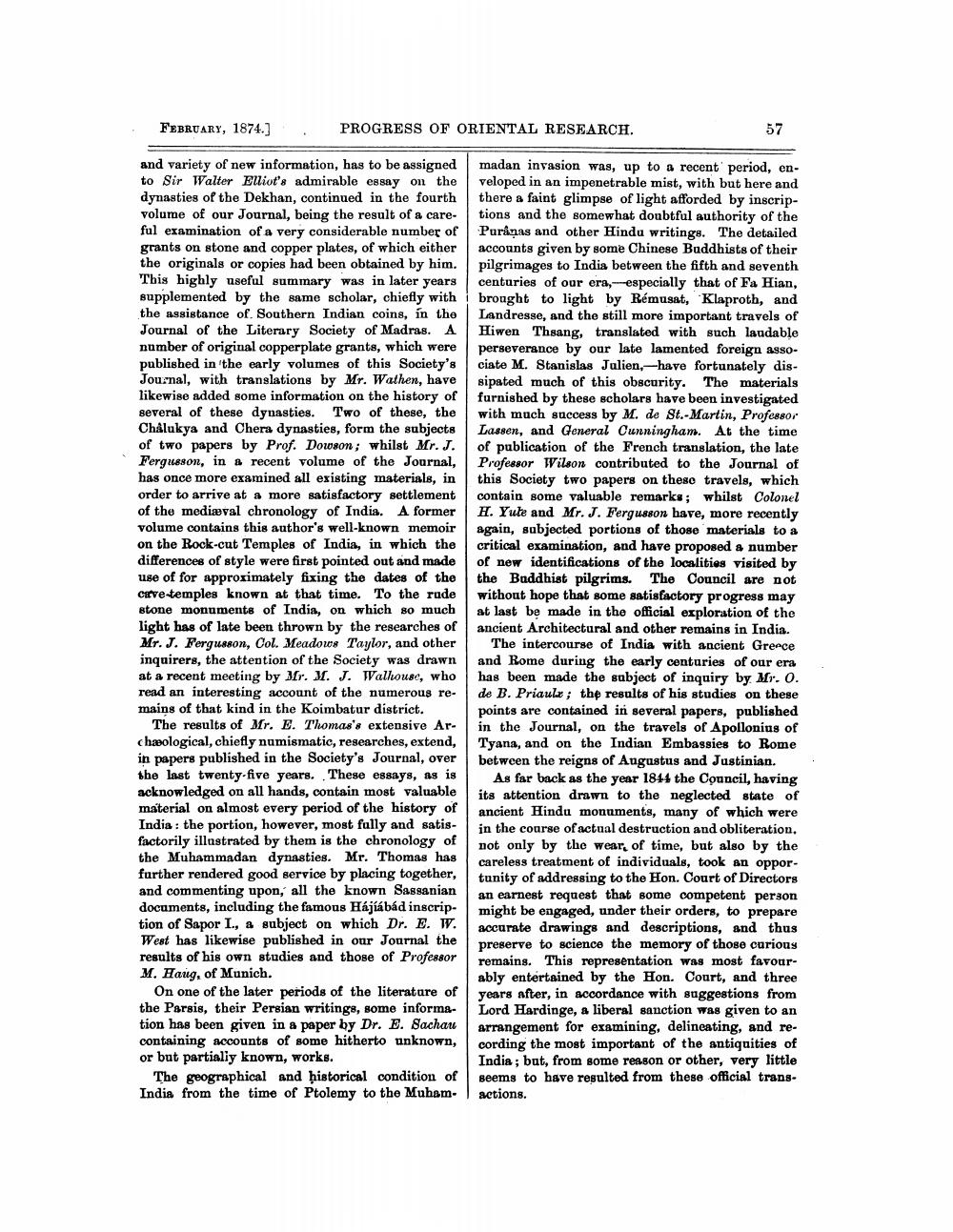________________
FEBRUARY, 1874.)
.
PROGRESS OF ORIENTAL RESEARCH.
57
and variety of new information, has to be assigned madan invasion was, up to a recent period, onto Sir Walter Elliot's admirable essay on the veloped in an impenetrable mist, with but here and dynasties of the Dekhan, continued in the fourth there a faint glimpse of light afforded by inscripvolume of our Journal, being the result of a care- tions and the somewhat doubtful authority of the ful examination of a very considerable number of Puranas and other Hindu writings. The detailed grants on stone and copper plates, of which either accounts given by some Chinese Buddhists of their the originals or copies had been obtained by him. pilgrimages to India between the fifth and seventh This highly useful summary was in later years centuries of our era, especially that of Fa Hian, supplemented by the same scholar, chiefly with brought to light by Rémusat, Klaproth, and the assistance of Southern Indian coins, in the Landresse, and the still more important travels of Journal of the Literary Society of Madras. A Hiwen Thsang, translated with such laudable number of original copperplate grants, which were perseverance by our late lamented foreigu assopublished in the early volumes of this Society's ciate M. Stanislas Julien-have fortunately disJournal, with translations by Mr. Wathen, have sipated much of this obscurity. The materials likewise added some information on the history of furnished by these scholars have been investigated several of these dynasties. Two of these, the with much success by M. de St. Martin, Professor Chalukya and Chera dynasties, form the subjects Lassen, and General Cunningham. At the time of two papers by Prof. Dowson; whilst Mr. J. of publication of the French translation, the late Ferguson, in a recent volume of the Journal, Professor Wilson contributed to the Journal of has once more examined all existing materials, in this Society two papers on theso travels, which order to arrive at a more satisfactory settlement contain some valuable remarks; whilst Colonel of the mediaval chronology of India. A former H. Yule and Mr. J. Fergusson have, more recently volume contains this author's well-known memoir again, subjected portions of those materials to a on the Rock-cut Temples of India, in which the critical examination, and have proposed a number differences of style were first pointed out and made of new identifications of the localities visited by use of for approximately fixing the dates of the the Buddhist pilgrims. The Council are not curve-temples known at that time. To the rude without hope that some satisfactory progress may stone monuments of India, on which so much at last be made in the official exploration of the light has of late been thrown by the researches of ancient Architectural and other remains in India. Mr. J. Fergusson, Col. Meadows Taylor, and other The intercourse of India with ancient Grence inquirers, the attention of the Society was drawn and Rome during the early centuries of our era at a recent meeting by Mr. J. J. Walhouse, who has been made the subject of inquiry by Mr. 0. read an interesting account of the numerous re- de B. Priaulx; the results of his studies on these mains of that kind in the Koimbatur district. points are contained in several papers, published
The results of Mr. E. Thomas's extensive Ar- in the Journal, on the travels of Apollonius of chæological, chiefly numismatic, researches, extend, Tyana, and on the Indian Embassies to Rome in papers published in the Society's Journal, over between the reigns of Augustus and Justinian the last twenty-five years. These essays, as is | As far back as the year 1844 the Council, having acknowledged on all hands, contain most valuable its attention drawn to the neglected state of material on almost every period of the history of ancient Hindu monuments, many of which were India: the portion, however, most fully and satis- in the course of actual destruction and obliteration, factorily illustrated by them is the chronology of
not only by the wear, of time, but also by the the Muhammadan dynasties. Mr. Thomas has
careless treatment of individuals, took an opporfurther rendered good service by placing together,
tunity of addressing to the Hon. Court of Directors and commenting upon, all the known Sassanian
an earnest request that some competent person documents, including the famous Hájíábád inscrip- might be engaged, under their orders, to prepare tion of Sapor I., & subject on which Dr. E. W.
accurate drawings and descriptions, and thus West has likewise published in our Journal the preserve to science the memory of those carious results of his own studies and those of Professor remains. This representation was most favourM. Haug, of Munich.
ably entertained by the Hon. Court, and three On one of the later periods of the literature of years after, in accordance with suggestions from the Parsis, their Persian writings, some informa- Lord Hardinge, a liberal sanction was given to an tion has been given in a paper by Dr. E. Sachar arrangement for examining, delineating, and recontaining accounts of some hitherto unknown,
cording the most important of the antiquities of or but partialiy known, works.
India ; but, from some reason or other, very little The geographical and historical condition of seems to have resulted from those official transIndia from the time of Ptolemy to the Muham. actions.




